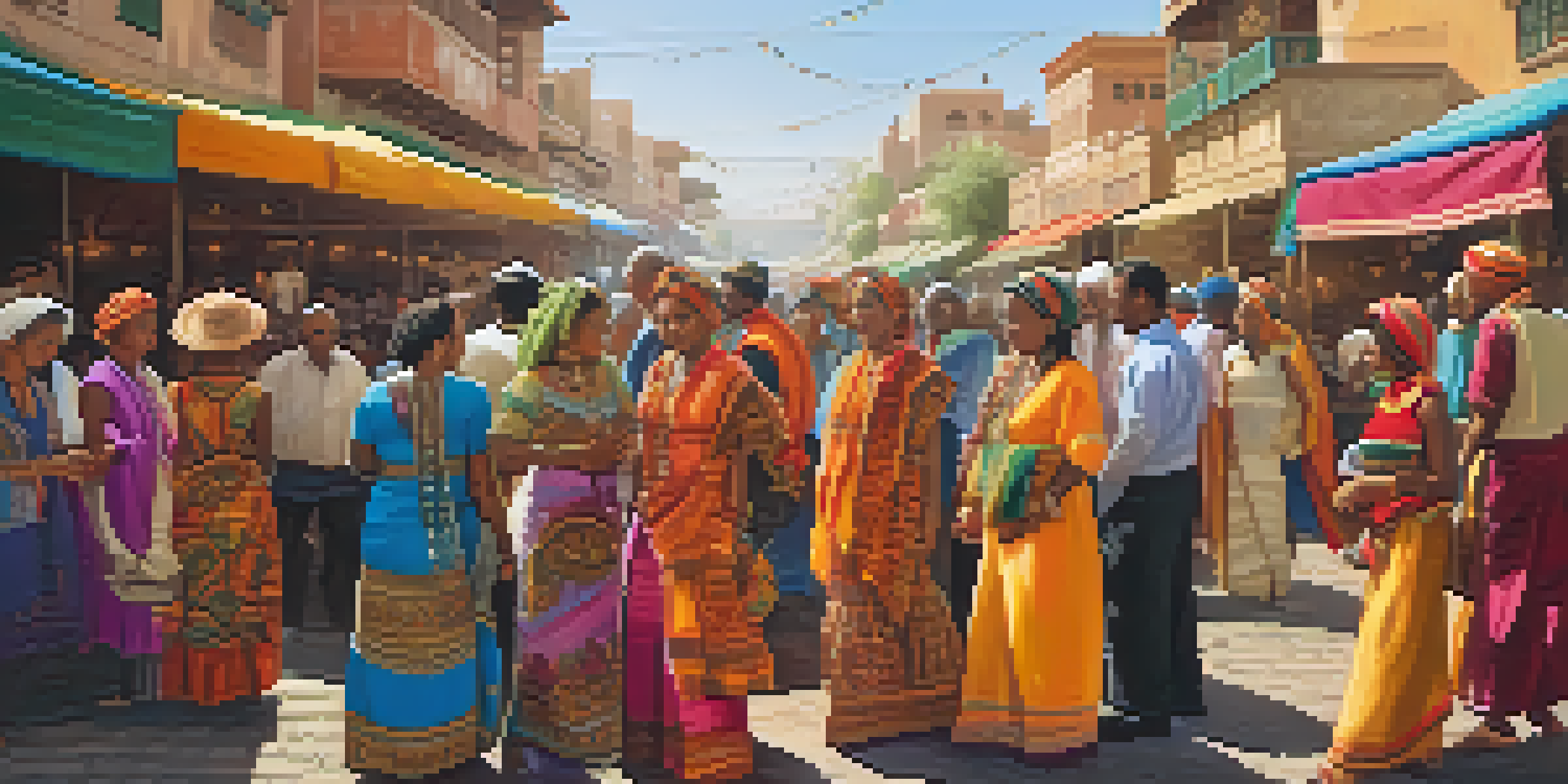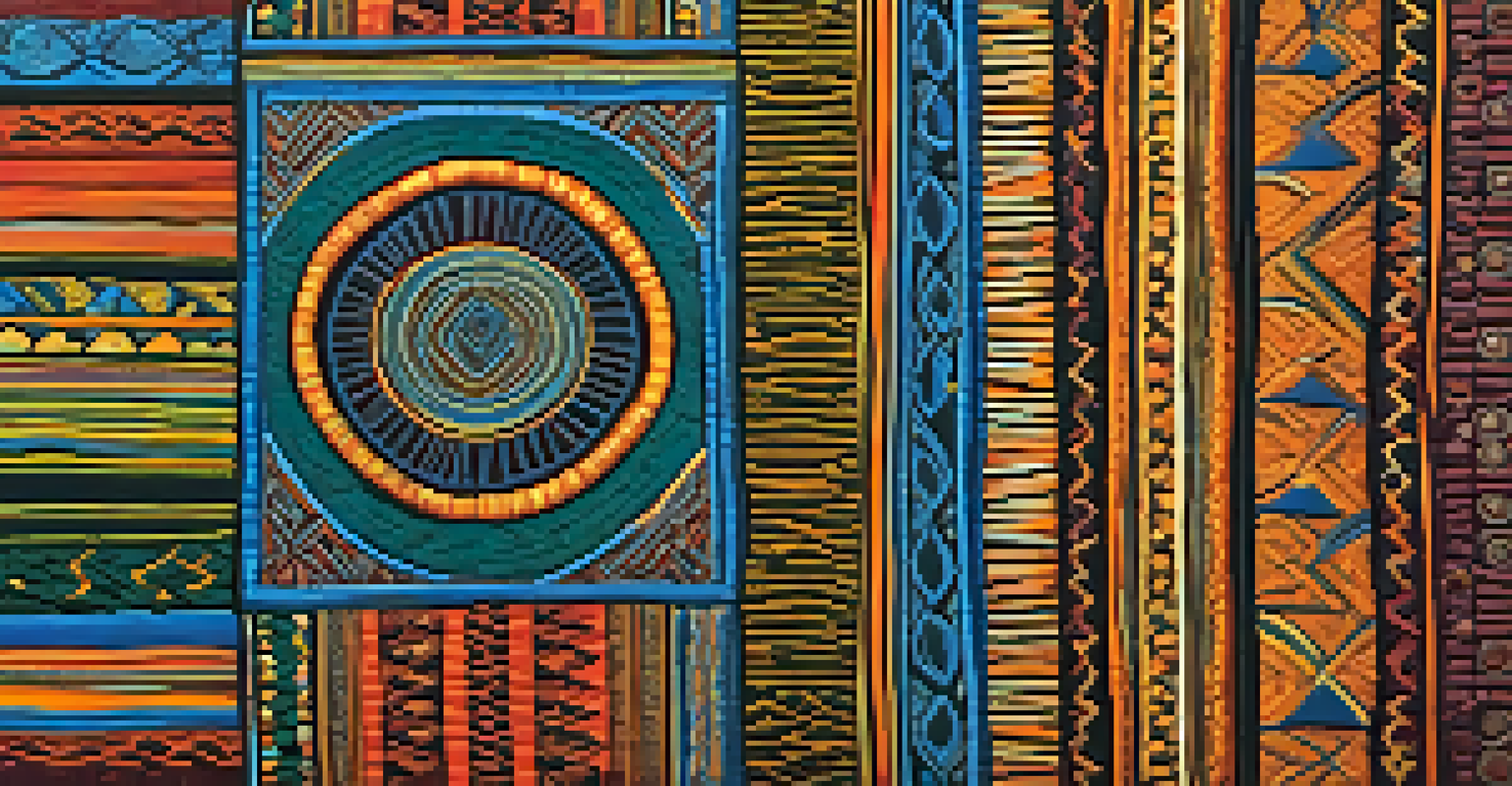Fashion as Art: The Intersection of Style and Cultural Identity

Understanding Fashion as a Form of Art
Fashion is more than just clothing; it's a dynamic form of art that communicates ideas and emotions. Just like traditional art forms, fashion utilizes creativity, design, and expression to convey messages about identity and society. Designers often draw inspiration from various artistic movements, blending aesthetics with functionality.
Fashion is the armor to survive the reality of everyday life.
Take, for example, the vibrant colors and bold patterns seen in African textiles, which are not only visually striking but also rich with cultural significance. This fusion of style and meaning illustrates how fashion can transcend mere practicality, becoming a canvas for cultural storytelling.
Ultimately, fashion as art invites us to explore our creativity while engaging with diverse cultural narratives. It encourages individuals to express their identities through the garments they choose, making each outfit a unique work of art.
Cultural Identity: A Tapestry Woven with Threads
Cultural identity is often expressed through fashion, reflecting the values, traditions, and histories of different communities. Clothing can signify belonging to a particular group, showcasing heritage and pride. For instance, the traditional attire worn during cultural festivals often highlights the richness of a community's customs and beliefs.

Moreover, fashion can serve as a bridge, connecting different cultures. When people adopt styles from various backgrounds, it fosters appreciation and understanding, creating a vibrant tapestry of global fashion influences. This exchange not only enriches personal style but also promotes dialogue about cultural diversity.
Fashion as Cultural Expression
Fashion serves as a canvas for individuals to showcase their cultural identities and stories through their clothing choices.
Thus, fashion becomes a powerful medium through which individuals can celebrate their heritage while also engaging in a global conversation about identity and belonging. It allows us to wear our stories, making our cultural identities visible to the world.
The Role of Designers in Shaping Cultural Narratives
Designers play a pivotal role in translating cultural narratives into wearable art. By incorporating traditional techniques and motifs into modern designs, they preserve cultural heritage while also appealing to contemporary tastes. This process not only keeps traditions alive but also allows them to evolve with time.
Clothes mean nothing until someone lives in them.
Take fashion designer Isabel Toledo, who celebrated her Cuban roots through vibrant colors and unique silhouettes. Her work not only showcased her identity but also introduced elements of Cuban culture to a global audience, fostering appreciation for her heritage.
In this way, designers act as cultural ambassadors, using their platforms to tell stories and evoke emotions through their creations. They have the power to challenge stereotypes and promote inclusivity, making fashion a medium for cultural expression and understanding.
The Impact of Fashion on Social Movements
Fashion has often been a catalyst for social change, reflecting and influencing cultural movements. From the suffragette white dresses to the bold colors of the LGBTQ+ pride flag, clothing choices can symbolize resistance and empowerment. This connection between fashion and activism highlights how style can serve as a powerful statement.
For example, the Black Lives Matter movement has seen activists wearing specific apparel to promote awareness and solidarity. These choices are not mere fashion statements; they carry deep messages about justice, equality, and identity, illustrating how clothing can amplify voices and drive change.
Designers as Cultural Ambassadors
Designers play a crucial role in preserving and evolving cultural narratives through their innovative and meaningful designs.
Thus, fashion becomes a tool for activism, allowing individuals to express their beliefs and connect with others. This intersection of style and social movements underscores the significant role fashion plays in shaping cultural identity and promoting social justice.
Sustainable Fashion: A New Cultural Identity
As awareness of environmental issues grows, sustainable fashion is emerging as a new cultural identity. This movement encourages individuals to consider the impact of their clothing choices on the planet and society. By prioritizing ethical practices and eco-friendly materials, fashion is evolving into a more responsible art form.
For instance, brands that focus on upcycling or using organic materials not only promote sustainability but also celebrate cultural craftsmanship. This approach respects traditional techniques while addressing modern concerns, fostering a deeper connection between consumers and their clothing.
Sustainable fashion represents a shift in cultural values, where the emphasis is on quality, longevity, and ethical production. It challenges us to rethink our relationship with clothing, encouraging a more mindful approach to style that resonates with our identities and beliefs.
Fashion Trends as Reflections of Cultural Shifts
Fashion trends often serve as mirrors reflecting broader cultural shifts in society. For example, the rise of streetwear has democratized fashion, blending high-end style with everyday wear, making it accessible to a wider audience. This evolution signifies a cultural shift toward valuing individual expression over traditional fashion norms.
Moreover, trends can highlight social issues, such as body positivity and inclusivity, which have gained traction in recent years. As more brands embrace diverse body types and backgrounds, fashion not only evolves but also fosters a sense of belonging and acceptance among consumers.
Fashion Drives Social Change
Fashion has the power to reflect and influence social movements, making clothing a medium for activism and empowerment.
Ultimately, these trends reveal the ongoing dialogue between fashion and cultural identity. They remind us that our clothing choices are a reflection of our values, beliefs, and the ever-changing world around us.
The Future of Fashion and Cultural Identity
As we look to the future, the relationship between fashion and cultural identity will continue to evolve. With advancements in technology and an increasing emphasis on sustainability, the way we create, consume, and express ourselves through fashion is changing. Virtual fashion shows and digital clothing are just the beginning of this transformation.
Moreover, as global connectivity increases, the blending of cultural influences will likely lead to even more diverse fashion expressions. This fusion can result in innovative designs that celebrate multiple heritages, enriching the fashion landscape and fostering greater appreciation for cultural diversity.

In this dynamic environment, fashion will remain a powerful medium for exploring identity, creativity, and connection. The intersection of style and cultural identity will continue to inspire individuals to express themselves authentically, making fashion a vibrant art form that reflects our shared humanity.